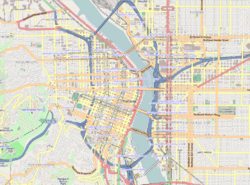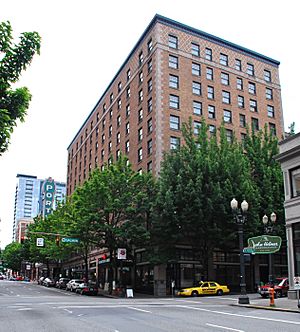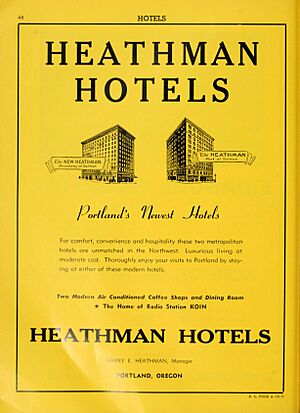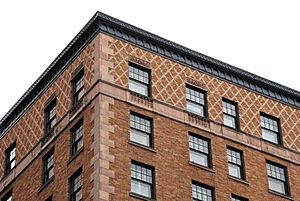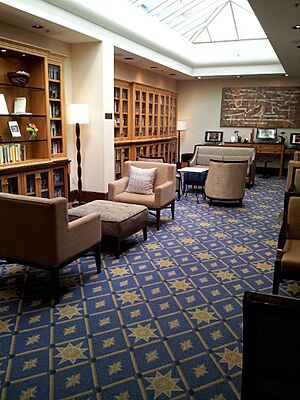Heathman Hotel facts for kids
Quick facts for kids |
|
|
New Heathman Hotel
|
|
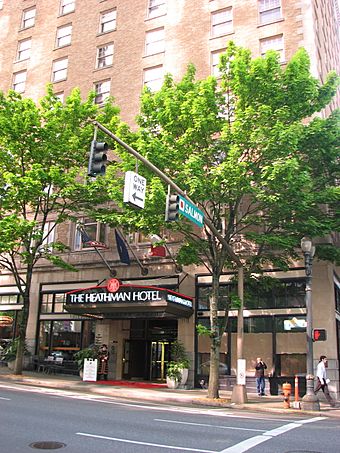
The façade of the Heathman Hotel on Broadway at Salmon Street in Portland. One of the hotel's iconic costumed greeters is visible to the left of the entrance.
|
|
| Location | 712 SW Salmon Street Portland, Oregon |
|---|---|
| Built | 1927 |
| Architect | DeYoung & Roald |
| Architectural style | Jacobean Revival |
| NRHP reference No. | 84003087 |
| Added to NRHP | February 16, 1984 |
The Heathman Hotel is a famous hotel in Portland, Oregon, United States. It first opened in 1927 and was called the New Heathman Hotel. It is one of the few old, grand hotels still standing in Portland. The Heathman Hotel is part of Historic Hotels of America. This is a special program by the National Trust for Historic Preservation. The hotel was added to the National Register of Historic Places in 1984.
Contents
Hotel History: From Old to New
Building the Heathman Hotels
The first Heathman Hotel was built in Portland in 1926. It cost about $1 million. Rich lumber barons and railroad magnates wanted a fancy hotel. They wanted a place that offered comfort and excellence. This first hotel had 11 stories and 300 rooms.
Because the first hotel was so popular, George Heathman built a second one. This new hotel was just one block away. The New Heathman Hotel was finished in 1927. It was a 10-story building made of concrete and brick. Its style was called Jacobean Revival. This design was created by Portland architects DeYoung and Roald.
The New Heathman was Portland's biggest building project at the time. About 1,200 workers helped build it. They were all invited to a special party before it opened. The hotel officially opened on December 17, 1927.
A Grand Opening and Radio Days
When the New Heathman was ready, important leaders spoke. These included Governor I. L. Patterson and Mayor George Luis Baker. Radio station KOIN played live music for the event. The Oregon Journal newspaper called it "Portland's newest and most modern hotel." They said it was built with the best human skill.
In 1927, Broadway was a lively street. It was known as Portland's "Great White Way." This area was full of theaters, restaurants, and shops. The hotel was surrounded by bright marquee lights. George Heathman also planned a large coffee shop. It was meant to be the biggest in the Pacific Northwest.
Radio station KOIN moved into the New Heathman in 1927. Later, KOIN got a sister station called KALE. KALE also moved into the hotel's studios. The mezzanine floor was changed to fit the radio stations. By 1940, these studios were considered "the finest broadcast facility in the country." KOIN eventually moved out in 1955.
The hotel's coffee shop closed over time. The space was later used for a political office. The area that is now the hotel's entrance once had a drug store and gift shop. This drug store was famous for being Portland's first 24-hour pharmacy.
George Heathman passed away young, at 49. This was less than three years after the New Heathman was finished. His family continued to be involved with the hotel. His son, Harry, managed it until 1962.
In the 1950s, many businesses left downtown Portland. They moved to the suburbs instead. By the late 1960s, Broadway had lost most of its businesses. City leaders then worked to bring life back to downtown. They wanted to keep stores there and build new ones.
The city also worked to bring music and theater back to Broadway. The old Paramount Theatre became The Arlene Schnitzer Concert Hall. This concert hall is right next to the New Heathman. City planners saw that the hotel's condition was important. It needed to be good for the concert hall to succeed.
In 1984, the Heathman Hotel was added to the National Register of Historic Places. At that time, its interior was described as "ill maintained, inadequate and outdated." Many parts of the hotel were empty.
Modern Renovations and New Owners
The New Heathman was very important to the area. So, in 1984, a big renovation began. It cost $16 million and took two years. The word "New" was removed from its name. The original Heathman Hotel had already been renamed.
The hotel's public areas were updated with new materials. These included marble and teak wood. The original exterior was restored. A 100-year-old crystal chandelier was added. It used to be in the U.S. Embassy in Czechoslovakia. Paintings by French artist Claude Lorrain were also installed. The guest rooms were decorated in different old styles. These included Biedermeier and Ming styles. As part of this update, the main entrance moved. It changed from Salmon Street to Broadway. This was to follow new city design rules.
The Stevenson family sold the hotel in 2000. It was bought by the Rim Corporation. The price was around $25 million. A restaurant chain, McCormick & Schmick's, started managing the hotel's restaurant. Rim Corporation decided to use the "Heathman" name for its other hotels. In 2007, a new Heathman Hotel opened in Kirkland, Washington.
LaSalle Hotel Properties bought the Heathman in 2014 for $64.3 million. In 2018, Pebblebrook Hotel Trust bought it. They brought in Provenance Hotels to manage it. The hotel then had another big renovation. It cost about $20 million. The goal was to make it a luxurious hotel.
Hotel Features and Art
Special Amenities
The Heathman's motto is "Where Service is Still an Art." The hotel is known for its doormen. They dress in English Beefeater costumes. At the entrance, there is a bronze statue of a bulldog named Zelda. She is also dressed in a Beefeater costume. The statue has a dog bowl with fresh water. It was given by Banfield Pet Hospital in 2010. Zelda is famous from the "Zelda Wisdom" greeting cards.
Travel + Leisure magazine has named the Heathman one of the 500 Best Hotels in the World. This happened in 2005, 2006, 2007, 2009, and 2015. In 2011, Food & Wine magazine said the Heathman was one of America's most haunted hotels.
Supporting the Arts
The Heathman Hotel has many original artworks. It started supporting visual arts after the 1980s remodel. The hotel has about 250 paintings, photos, and other works. It focuses on American artists, especially those from the Northwestern United States. Prints from Andy Warhol's Endangered Species series are on most floors. One room is even designed to honor Warhol.
Art exhibits change with the seasons. You can see them on the mezzanine floor. These exhibits are chosen by Portland's Elizabeth Leach Gallery. The Heathman also has a library on the mezzanine. It has a large collection of books signed by authors who have stayed at the hotel.
Dining at the Heathman
The Heathman Restaurant & Bar was once managed by Landry's, Inc. It was known for its French-inspired Pacific Northwest cuisine. It was seen as one of Portland's best restaurants. In 2014, it earned four stars from the Forbes Travel Guide. In 2003, Anthony Bourdain wrote about a special menu there. It featured an all-offal meal made for him.
In 2016, the restaurant reopened as Headwaters at the Heathman. Chef Vitaly Paley ran it. Headwaters focused on seafood and Northwest dishes. However, due to the COVID-19 pandemic, Headwaters closed.
The Hotel During COVID-19
Like many hotels in Portland, the Heathman Hotel paused operations. This happened in late March 2020. It was to help stop the spread of COVID-19. Travel to Portland did not return to normal levels. The hotel stayed closed until October 2020. Management reorganized and prepared to reopen safely. They added new health and safety rules for travelers.


